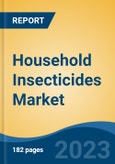Speak directly to the analyst to clarify any post sales queries you may have.
10% Free customizationThis report comes with 10% free customization, enabling you to add data that meets your specific business needs.
Key Market Drivers
Health Concerns and Vector-Borne Diseases
In recent years, the global household insecticides market has experienced a significant surge in growth, and one of the primary catalysts behind this expansion is the escalating health concerns associated with vector-borne diseases. As the world grapples with the increasing prevalence of diseases transmitted by insects, the demand for effective pest control solutions within households has become more pronounced. The rise in vector-borne diseases, including but not limited to dengue, Zika, malaria, and Lyme disease, has become a global health challenge. Mosquitoes, ticks, and other insects act as vectors, transmitting pathogens that can cause severe illnesses. The threat of these diseases has heightened public awareness about the importance of preventing insect bites and controlling vector populations.Household insecticides have emerged as crucial tools in the prevention of vector-borne diseases. These products are designed to target and eliminate insects within residential spaces, reducing the likelihood of disease transmission. Aerosol sprays, mosquito coils, and vaporizers, among other formulations, provide consumers with accessible and effective means to protect themselves and their families. Rapid urbanization, especially in densely populated areas, has created environments conducive to the proliferation of insects. Urban dwellers are more vulnerable to vector-borne diseases due to close living quarters and increased exposure to insect habitats. This vulnerability has driven the demand for household insecticides as a proactive measure to curb disease transmission within urban settings.
Public health campaigns and awareness initiatives have played a pivotal role in highlighting the risks associated with vector-borne diseases. These campaigns educate the public about the importance of personal protection and the role of household insecticides in preventing insect-borne illnesses. Increased awareness has translated into a higher demand for these products.
Climate change and increased international travel have broadened the reach of disease-carrying insects, exposing new populations to diseases like malaria, dengue fever, Zika virus, and Lyme disease. For example, in 2022, the EU/EEA reported 1,133 cases and 92 deaths from West Nile virus, with 1,112 of those cases acquired locally across 11 countries. The World Health Organization (WHO) estimates that over 700,000 deaths occur annually from diseases like malaria and dengue. As these insect-borne diseases continue to spread, the demand for household insecticides is expected to rise.
Key Market Challenges
Environmental Concerns and Sustainability
One of the foremost challenges confronting the industry is the increasing scrutiny of the environmental impact of household insecticides. Traditional formulations often contain chemicals that may have adverse effects on ecosystems. The push for more sustainable and eco-friendly solutions necessitates a shift in formulations and practices, driving manufacturers to balance effectiveness with environmental responsibility.Key Market Trends
Sustainable Formulations Take Center Stage
An increasing emphasis on environmental sustainability is reshaping the formulations of household insecticides. Consumers are demanding eco-friendly alternatives that minimize harm to the environment while effectively controlling pests. Manufacturers are responding by incorporating natural and biodegradable ingredients, reducing the ecological footprint of their products.Key Market Players
- Amplecta AB
- FMC Global Specialty Solutions
- Godrej Consumer Products Limited
- Natural Insecto Products Inc
- Nicols International SA
- S.C. Johnson & Son Inc.
- Shogun Organics Limited
- Spectrum Brands Holdings, Inc.
- Bayer AG
- Aristo Biotech and Life Science Pvt. Ltd
Report Scope:
In this report, the Global Household Insecticides Market has been segmented into the following categories, in addition to the industry trends which have also been detailed below:Household Insecticides Market, By Insect Type:
- Mosquitoes & Flies
- Rats & other Rodents
- Termites
- Bedbugs & Beetles
- Others
Household Insecticides Market, By Chemical Type:
- Synthetic
- Natural
Household Insecticides Market, By Form:
- Dust and Granules
- Liquids
- Aerosol Sprays
- Other
Household Insecticides Market, By Region:
- North America
- United States
- Canada
- Mexico
- Europe
- Germany
- United Kingdom
- France
- Italy
- Spain
- Asia-Pacific
- China
- Japan
- India
- Australia
- South Korea
- South America
- Brazil
- Argentina
- Colombia
- Middle East & Africa
- South Africa
- Saudi Arabia
- UAE
- Kuwait
Competitive Landscape
Company Profiles: Detailed analysis of the major companies present in the Global Household Insecticides Market.Available Customizations:
With the given market data, the publisher offers customizations according to a company's specific needs. The following customization options are available for the report.Company Information
- Detailed analysis and profiling of additional market players (up to five).
This product will be delivered within 1-3 business days.
Table of Contents
Companies Mentioned
- Amplecta AB
- FMC Global Specialty Solutions
- Godrej Consumer Products Limited
- Natural Insecto Products Inc
- Nicols International SA
- S.C. Johnson & Son Inc.
- Shogun Organics Limited
- Spectrum Brands Holdings, Inc.
- Bayer AG
- Aristo Biotech and Life Science Pvt. Ltd
Table Information
| Report Attribute | Details |
|---|---|
| No. of Pages | 180 |
| Published | February 2025 |
| Forecast Period | 2024 - 2030 |
| Estimated Market Value ( USD | $ 24.12 Billion |
| Forecasted Market Value ( USD | $ 35.25 Billion |
| Compound Annual Growth Rate | 6.5% |
| Regions Covered | Global |
| No. of Companies Mentioned | 10 |









